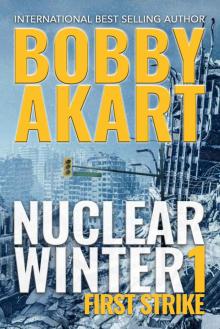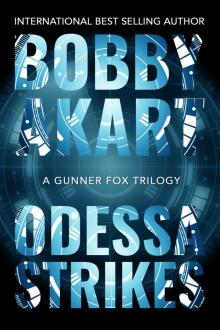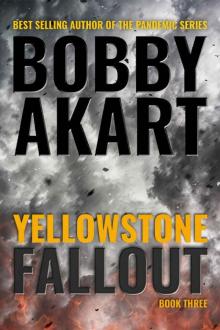- Home
- Bobby Akart
Asteroid Destruction
Asteroid Destruction Read online
Thank you for downloading ASTEROID: DESTRUCTION, book three of the Asteroid series, a Gunner Fox trilogy, by Author Bobby Akart.
For free books, updates on new releases, special offers, and bonus content
Click Here to Sign Up
or visit my dedicated feature page on Amazon at
Amazon.com/BobbyAkart
or visit me online at
BobbyAkart.com
PRAISE FOR THE ASTEROID SERIES
“Akart draws you into a story in such a way that you’ll be anxiously casting your eyes to the sky in nervous anticipation.”
“Not since Lucifer’s Hammer have readers’ imaginations been captured by the very real threats that imperil our planet from space.”
“Hollywood got it wrong. NASA has to rethink their intergalactic tactics because these global killers are far tougher than we think. Akart’s research lays open the fact that we’re wholly unprepared for an extinction-level event caused by a devastating asteroid impact.”
“America needs a real hero, and Akart gave us Gunner Fox!”
Other Works by Amazon Top 50 Author Bobby Akart
The Asteroid Series
Discovery
Diversion
Destruction
The Doomsday Series
Apocalypse
Haven
Anarchy
Minutemen
Civil War
The Yellowstone Series
Hellfire
Inferno
Fallout
Survival
The Lone Star Series
Axis of Evil
Beyond Borders
Lines in the Sand
Texas Strong
Fifth Column
Suicide Six
The Pandemic Series
Beginnings
The Innocents
Level 6
Quietus
The Blackout Series
36 Hours
Zero Hour
Turning Point
Shiloh Ranch
Hornet’s Nest
Devil’s Homecoming
The Boston Brahmin Series
The Loyal Nine
Cyber Attack
Martial Law
False Flag
The Mechanics
Choose Freedom
Patriot’s Farewell
Seeds of Liberty (Companion Guide)
The Prepping for Tomorrow Series
Cyber Warfare
EMP: Electromagnetic Pulse
Economic Collapse
ASTEROID: DESTRUCTION
The Asteroid Series, Book Three
by
Bobby Akart
Contents
Dedications
Acknowledgements
About the Author, Bobby Akart
Author’s Introduction to the Asteroid Series
Real-world news excerpts
Epigraph
Prologue
PART ONE
Chapter 1
Chapter 2
Chapter 3
Chapter 4
Chapter 5
Chapter 6
Chapter 7
Chapter 8
Chapter 9
Chapter 10
Chapter 11
Chapter 12
PART TWO
Chapter 13
Chapter 14
Chapter 15
Chapter 16
Chapter 17
Chapter 18
Chapter 19
Chapter 20
Chapter 21
Chapter 22
Chapter 23
PART THREE
Chapter 24
Chapter 25
Chapter 26
Chapter 27
Chapter 28
Chapter 29
Chapter 30
Chapter 31
Chapter 32
Chapter 33
Chapter 34
PART FOUR
Chapter 35
Chapter 36
Chapter 37
Chapter 38
Chapter 39
Chapter 40
Chapter 41
Chapter 42
Chapter 43
Chapter 44
Chapter 45
Chapter 46
PART FIVE
Chapter 47
Chapter 48
Chapter 49
Chapter 50
Chapter 51
Chapter 52
Copyright Information
Dedications
For many years, I have lived by the following premise:
Because you never know when the day before is the day before, prepare for tomorrow.
My friends, I study and write about the threats we face, not only to both entertain and inform you, but because I am constantly learning how to prepare for the benefit of my family as well. There is nothing more important on this planet than my darling wife, Dani, and our two girls, Bullie and Boom. One day the apocalypse will be upon us, and I’ll be damned if I’m gonna let it stand in the way of our life together.
The Asteroid series is dedicated to the love and support of my family. I will always protect you from anything that threatens us.
Acknowledgements
Writing a book that is both informative and entertaining requires a tremendous team effort. Writing is the easy part. For their efforts in making the Asteroid series a reality, I would like to thank Hristo Argirov Kovatliev for his incredible cover art, Pauline Nolet for her editorial prowess, Stef Mcdaid for making this manuscript decipherable in so many formats, Chris Abernathy for his memorable performance in narrating this novel, and the Team—Denise, Joe, Jim, Shirley, and Kenda—whose advice, friendship and attention to detail is priceless.
You’ll be introduced to two characters in this story who, through their generous donations to charities my family supports, won the right to have a character named after them. One is a gentleman named Sparky Newsome in Washington, Georgia who bid at a local Rotary Club auction. As it happened, Sparky is the editor and owner of the local newspaper, The News-Reporter. This changed the trajectory of my story’s outline considerably, and for the better.
The use of Mr. Newsome in the Asteroid trilogy, led to incorporating Washington, Georgia as a location, which then led me to the Deerlick Astronomy Village in nearby Crawfordville. Founded by two astronomers in 2005, the DAV is considered one of the darkest locations in the Eastern United States by DarkFinder.com.
Jackie Holcombe, who donated to a special program at Village Veterinary Medical Center in Farragut, Tennessee that supports people who can’t afford extraordinary medical procedures for their pets, was also a named character in the series. She earned a prominent role in the story, alongside Mr. Newsome, as you will see. A huge thank you to both of them for their generosity and allowing me to include them in this series.
The research associated with this project surpassed that of the Yellowstone series. In fact, the premise for this story resulted from my conversations with the team of scientists at NASA’s Jet Propulsion Laboratory at CalTech over a year ago.
As I dug into the science, once again, source material and research papers were heaped upon my shoulders. My email inbox was put into circuit overload as so many folks from around the globe contributed to my research. One thing is certain—astrophysicists are uniform in their desire to inform the public as to the threats we face from near-Earth objects, especially those that are recently discovered, or remain undiscovered.
There are so many people and organizations to thank, so let me name a few.
I was fortunate enough to be introduced to some brilliant members of our military at Wright-Patterson Air Force Base in Ohio. The USAF’s Aeronautical Systems Division, the ASD, pr
ovided me invaluable insight into America’s future fighting aircraft. They told me what are capabilities are today, and where they’d likely be ten years from now, and beyond. Literally, the sky’s the limit for these folks. Don’t be surprised that one day, we’ll be flying fighter jets in space.
Also, a great source for the technical descriptions of the aircraft of our adversaries was provided by the US Naval Institute’s Military Database in Arlington, Virginia. A big thank you to Melissa Cartwright for helping me navigate through a sea of information. Let me add, anyone who thinks we should be cutting our defense budget is short-sighted, or uninformed. The military capabilities of Russia and China will astound you.
As I’ve already mentioned, my research regarding the Yellowstone Caldera started with the work of Dr. Brian H. Wilcox, an aerospace engineer at the Jet Propulsion Laboratory in Pasadena, California. Although his proposition that our greatest threat to humankind may not necessarily come from above, in the form of a near-Earth object, but rather, from below, as an eruption from the Yellowstone Supervolcano, he has cautioned that it’s the newly discovered asteroids that have the potential to be planet killers. Frankly, I don’t know how Dr. Wilcox sleeps at night.
Lastly, I must make mention of the team at NASA’s Planetary Defense Coordination Office. The PDCO employs a variety of ground and space-based telescopes to search for near-Earth objects, determines their orbits, and measures their physical characteristics in order to accurately assess the threat to our planet. Their functions including warning our government of the threats, suggesting mitigation techniques to alter the course of an incoming object, and acts to coordinate with multiple agencies as an emergency response is formulated. Thank you to Linda Billings and others in the Public Communications office at the PDCO; Patricia Talbert in the Professional Outreach department; and of course, Lindley Johnson, the Program Executive of the PDCO.
Without their efforts, this story could not be told.
Thank you all!
About the Author, Bobby Akart
Author Bobby Akart has been ranked by Amazon as #50 on the Amazon Charts list of most popular, bestselling authors. He has achieved recognition as the #1 bestselling Horror Author, #2 bestselling Science Fiction Author, #3 bestselling Religion & Spirituality Author, #6 bestselling Action & Adventure Author, #7 bestselling Historical Author and #10 bestselling Thriller Author.
He has written over thirty international bestsellers, in nearly fifty fiction and nonfiction genres, including the chart-busting Yellowstone series, the thought-provoking Doomsday series, the reader-favorite Lone Star series, the critically acclaimed Boston Brahmin series, the bestselling Blackout series, the frighteningly realistic Pandemic series, his highly cited nonfiction Prepping for Tomorrow series, and his latest project—the Asteroid series, a scientific thriller that will remind us all that life on Earth may have begun, and might well end, with something from space.
His novel Yellowstone: Fallout reached the Top 50 on the Amazon bestsellers list and earned him two Kindle All-Star awards for most pages read in a month and most pages read as an author. The Yellowstone series vaulted him to the #1 bestselling horror author on Amazon, and the #2 bestselling science fiction author.
Bobby has provided his readers a diverse range of topics that are both informative and entertaining. His attention to detail and impeccable research has allowed him to capture the imaginations of his readers through his fictional works and bring them valuable knowledge through his nonfiction books.
SIGN UP for Bobby Akart’s mailing list to receive special offers, bonus content, and you’ll be the first to receive news about new releases in the Asteroid series.
VISIT Amazon.com/BobbyAkart, a dedicated feature page created by Amazon for his work, to view more information on his thriller fiction novels and post-apocalyptic book series, as well as his nonfiction Prepping for Tomorrow series. Visit Bobby Akart’s website for informative blog entries on preparedness, writing, and a behind-the-scenes look into his novels.
www.BobbyAkart.com
Author’s Introduction to the Asteroid Series
June 13, 2019
I want you to imagine how vast our solar system is …
For those of us stuck on Earth, we might gaze up into the night sky and marvel at the size of our solar system, but we’ll never get the opportunity to get a closer look. We take for granted the Sun that brightens our day, or the mysterious Moon that appears at night. The trained eye can pick out constellations and even other planets, if one knows where to look.
But just how big is our solar system? Before you can appreciate its vastness, let’s consider the units of measurement that give it a sense of scale. Distances are so large that measurements like feet and miles are irrelevant. Most distances are defined in astronomical units, or AUs. One AU, based upon the distance from the Earth to the Sun, is roughly equal to ninety-three-million-miles.
To put that into perspective, if you flew around our planet, you’d cover twenty-five thousand miles. If you traveled to the moon, you’d cover about ten times that, or two-hundred-forty-thousand miles. To reach the sun, we’re looking at almost forty times the distance to the moon. And finally, to reach the outer limits of our solar system, where the Oort Cloud is located, is over one-hundred-thousand AUs, or nearly two light years away.
Now, that’s a lot of space, pardon the pun. It would take our fastest spacecraft thirty-seven thousand years to get there.
That said, however, space objects travel the vast openness of our solar system with regularity. Over many millions of years, these objects, both large and small, wander the solar system. Some remain within the gravitational orbit of larger bodies, or within the asteroid belt that exists between Mars and Jupiter.
Others, the wayward nomads who are looking for a larger object’s gravity to become attached to, float aimlessly, and mostly harmlessly, through space for years and years and years. Until …
They collide with other objects.
Asteroids are typically material left over from the period of planetary formation four-and-a-half billion years ago. They’re the remains of what didn’t form into planets in the inner solar system, or often the result of collisions in the past.
They vary in size from only a few feet to the big daddy of them all—Ceres, which measures about one-fourth the size of our moon. At almost six-hundred-miles wide, Ceres is about the size of Texas.
This story focuses on the threats our planet faces from a collision with a near-Earth object, or NEO. If you consider an asteroid can be as small as a few feet across, there are an estimated five-hundred-million of them considered to be near-Earth—between us and the Sun. If you limit the number to potentially hazardous asteroids, those within four-and-a-half million miles, then the number is reduced to around twenty-thousand.
That’s a lot of traffic in our neighborhood, and yet only ninety percent are accounted for. While NASA and other space agencies around the globe do an admirable job of identifying and tracking these NEOs, the fact of the matter is that they only have identified ninety percent of the threats. That leaves a one-in-ten-chance that an object remains undiscovered.
The big uncertainty is that we haven’t discovered many near-Earth asteroids, so we don’t know if they are on a collision course with Earth. Now, there is comfort in knowing that the vastness of space might make the odds in our favor that one of these wandering nomads doesn’t hit us.
However, because of the size of our planet, and the gravity associated with Earth, asteroids can be pulled toward us. It’s happened before, on many occasions.
NEO impact events have played a significant role in the evolution of our solar system since its formation. Major impact events have significantly shaped Earth's history, have been implicated in the formation of the Earth–Moon system, the evolutionary history of life, the origin of water on Earth and several mass extinctions. The famous prehistoric Chicxulub (cheek-sha-loob) impact, sixty-six million years ago, is believed to be the cause of the Cretaceo
us–Paleogene extinction event that resulted in the demise of the dinosaurs.
Could it happen again? Absolutely. When? Nobody knows. At present, there are only a few potentially close-shaves in our future, at least, that we know of. It’s the ones that we haven’t discovered that keep astrophysicists and amateur astronomers up at night, watching the skies.
Thank you for reading and I know you’ll enjoy the Asteroid series, a Gunner Fox trilogy.
Real-world news excerpts
A Massive Asteroid Got Extremely Close to Earth and Scientists Didn’t Know Until it Was Only Days Away ~ Yahoo News, July 28, 2019
The 427 foot wide asteroid got within 45,000 miles of Earth last week. That’s only twenty percent of the distance between the Earth and the Moon, that qualifies as a pretty narrow miss.
Dubbed a “city-killer”, it was classified because it would strike the planet with the force of multiple nuclear bombs capable of destroying America’s largest cities.
How did they miss this?
While NASA and other agencies have technology to track objects like this, there isn’t enough funding to observe every single one. NASA manages to track less than one third of the major asteroids.
“City Killer” asteroid misses Earth and Scientists had no idea ~ CBS News, June 29, 2019
Asteroid 2019 OK came hurtling toward Earth at a speed of 15 miles a second, according to NASA. It came as close as forty-five-thousand miles from our planet. The asteroid, about the size of a large boulder, only became visible a few days ago.
Astronomy professor, Alan Duffy, said it would have hit with over thirty times the energy of the atomic blast at Hiroshima during World War II.

 Geostorm The Collapse: A Post Apocalyptic EMP Survival Thriller (The Geostorm Series Book 3)
Geostorm The Collapse: A Post Apocalyptic EMP Survival Thriller (The Geostorm Series Book 3) Doomsday Apocalypse
Doomsday Apocalypse Nuclear Winter Desolation: Post Apocalyptic Survival Thriller (Nuclear Winter Series Book 5)
Nuclear Winter Desolation: Post Apocalyptic Survival Thriller (Nuclear Winter Series Book 5) Economic Collapse (Prepping for Tomorrow Book 2)
Economic Collapse (Prepping for Tomorrow Book 2) Nuclear Winter Armageddon
Nuclear Winter Armageddon Nuclear Winter Devil Storm
Nuclear Winter Devil Storm Virus Hunters 3: A Medical Thriller
Virus Hunters 3: A Medical Thriller Doomsday Civil War: A Post-Apocalyptic Survival Thriller (The Doomsday Series Book 5)
Doomsday Civil War: A Post-Apocalyptic Survival Thriller (The Doomsday Series Book 5) Asteroid Destruction
Asteroid Destruction Geostorm the Shift
Geostorm the Shift Asteroid Discovery
Asteroid Discovery Virus Hunters 2: A Medical Thriller
Virus Hunters 2: A Medical Thriller Geostorm The Shift: A Post-Apocalyptic EMP Survival Thriller (The Geostorm Series Book 1)
Geostorm The Shift: A Post-Apocalyptic EMP Survival Thriller (The Geostorm Series Book 1) Asteroid Diversion
Asteroid Diversion Nuclear Winter Devil Storm: Post Apocalyptic Survival Thriller (Nuclear Winter Series Book 4)
Nuclear Winter Devil Storm: Post Apocalyptic Survival Thriller (Nuclear Winter Series Book 4) Geostorm The Pulse: A Post Apocalyptic EMP Survival Thriller (The Geostorm Series Book 2)
Geostorm The Pulse: A Post Apocalyptic EMP Survival Thriller (The Geostorm Series Book 2) Yellowstone: Survival: A Post-Apocalyptic Survival Thriller (The Yellowstone Series Book 4)
Yellowstone: Survival: A Post-Apocalyptic Survival Thriller (The Yellowstone Series Book 4) Nuclear Winter First Strike: Post-Apocalyptic Survival Thriller
Nuclear Winter First Strike: Post-Apocalyptic Survival Thriller Nuclear Winter Whiteout
Nuclear Winter Whiteout Doomsday Anarchy
Doomsday Anarchy Pandemic: Level 6: A Post Apocalyptic Medical Thriller Fiction Series (The Pandemic Series Book 3)
Pandemic: Level 6: A Post Apocalyptic Medical Thriller Fiction Series (The Pandemic Series Book 3) Martial Law
Martial Law Odessa Reborn: A Terrorism Thriller (Gunner Fox Book 4)
Odessa Reborn: A Terrorism Thriller (Gunner Fox Book 4) New Madrid Earthquake
New Madrid Earthquake Beyond Borders: Post Apocalyptic EMP Survival Fiction (The Lone Star Series Book 2)
Beyond Borders: Post Apocalyptic EMP Survival Fiction (The Lone Star Series Book 2) The Blackout Series (Book 3): Turning Point
The Blackout Series (Book 3): Turning Point Patriot's Farewell: A Political Thriller Fiction Series (Boston Brahmin Political Thrillers Book 7)
Patriot's Farewell: A Political Thriller Fiction Series (Boston Brahmin Political Thrillers Book 7) Lines in the Sand_Post Apocalyptic EMP Survival Fiction
Lines in the Sand_Post Apocalyptic EMP Survival Fiction The Mechanics: A Post-Apocalyptic Fiction Series
The Mechanics: A Post-Apocalyptic Fiction Series The Loyal Nine
The Loyal Nine Axis of Evil
Axis of Evil Axis of Evil: Post Apocalyptic EMP Survival Fiction (The Lone Star Series Book 1)
Axis of Evil: Post Apocalyptic EMP Survival Fiction (The Lone Star Series Book 1) Lines in the Sand: Post Apocalyptic EMP Survival Fiction (The Lone Star Series Book 3)
Lines in the Sand: Post Apocalyptic EMP Survival Fiction (The Lone Star Series Book 3) Odessa Strikes
Odessa Strikes The Blackout Series (Book 4): Shiloh Ranch
The Blackout Series (Book 4): Shiloh Ranch Hornet's Nest: A Post Apocalyptic EMP Survival Fiction Series (The Blackout Series Book 5)
Hornet's Nest: A Post Apocalyptic EMP Survival Fiction Series (The Blackout Series Book 5) Yellowstone: Fallout: A Post-Apocalyptic Survival Thriller (The Yellowstone Series Book 3)
Yellowstone: Fallout: A Post-Apocalyptic Survival Thriller (The Yellowstone Series Book 3) Electromagnetic Pulse
Electromagnetic Pulse Texas Strong: Post Apocalyptic EMP Survival Fiction (The Lone Star Series Book 4)
Texas Strong: Post Apocalyptic EMP Survival Fiction (The Lone Star Series Book 4) Fifth Column_Post Apocalyptic EMP Survival Fiction
Fifth Column_Post Apocalyptic EMP Survival Fiction Patriot's Farewell
Patriot's Farewell Texas Strong_Post Apocalyptic EMP Survival Fiction
Texas Strong_Post Apocalyptic EMP Survival Fiction Pandemic: The Innocents: A Post-Apocalyptic Medical Thriller Fiction Series (The Pandemic Series Book 2)
Pandemic: The Innocents: A Post-Apocalyptic Medical Thriller Fiction Series (The Pandemic Series Book 2) Shiloh Ranch: A Post Apocalyptic EMP Survival Fiction Series (The Blackout Series Book 4)
Shiloh Ranch: A Post Apocalyptic EMP Survival Fiction Series (The Blackout Series Book 4) Cyber Attack
Cyber Attack Beyond Borders
Beyond Borders Choose Freedom: A Post-Apocalyptic Fiction Series (The Boston Brahmin Book 6)
Choose Freedom: A Post-Apocalyptic Fiction Series (The Boston Brahmin Book 6) False Flag
False Flag Turning Point: A Post Apocalyptic EMP Survival Fiction Series (The Blackout Series Book 3)
Turning Point: A Post Apocalyptic EMP Survival Fiction Series (The Blackout Series Book 3) Nuclear Winter First Strike
Nuclear Winter First Strike Pandemic: Beginnings: A Post-Apocalyptic Medical Thriller Fiction Series (The Pandemic Series Book 1)
Pandemic: Beginnings: A Post-Apocalyptic Medical Thriller Fiction Series (The Pandemic Series Book 1) Devil's Homecoming: A Post Apocalyptic EMP Survival Fiction Series (The Blackout Series Book 6)
Devil's Homecoming: A Post Apocalyptic EMP Survival Fiction Series (The Blackout Series Book 6) The Blackout Series (Book 6): Devil's Homecoming
The Blackout Series (Book 6): Devil's Homecoming Yellowstone: Inferno: A Post-Apocalyptic Survival Thriller (The Yellowstone Series Book 2)
Yellowstone: Inferno: A Post-Apocalyptic Survival Thriller (The Yellowstone Series Book 2) Fifth Column: Post Apocalyptic EMP Survival Fiction (The Lone Star Series Book 5)
Fifth Column: Post Apocalyptic EMP Survival Fiction (The Lone Star Series Book 5) Yellowstone: Hellfire: A Post-Apocalyptic Survival Thriller (The Yellowstone Series Book 1)
Yellowstone: Hellfire: A Post-Apocalyptic Survival Thriller (The Yellowstone Series Book 1) The Blackout Series (Book 2): Zero Hour
The Blackout Series (Book 2): Zero Hour Suicide Six: Post Apocalyptic EMP Survival Fiction (The Lone Star Series Book 6)
Suicide Six: Post Apocalyptic EMP Survival Fiction (The Lone Star Series Book 6) Suicide Six_Post Apocalyptic EMP Survival Fiction
Suicide Six_Post Apocalyptic EMP Survival Fiction Zero Hour: A Post-Apocalyptic EMP Survival Fiction Series (The Blackout Series Book 2)
Zero Hour: A Post-Apocalyptic EMP Survival Fiction Series (The Blackout Series Book 2) Beyond Borders_Post Apocalyptic EMP Survival Fiction
Beyond Borders_Post Apocalyptic EMP Survival Fiction Pandemic: Quietus: A Post-Apocalyptic Dystopian Fiction Series (The Pandemic Series Book 4)
Pandemic: Quietus: A Post-Apocalyptic Dystopian Fiction Series (The Pandemic Series Book 4) 36 Hours: A Post-Apocalyptic EMP Survival Fiction Series
36 Hours: A Post-Apocalyptic EMP Survival Fiction Series Cyber Warfare
Cyber Warfare